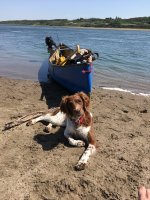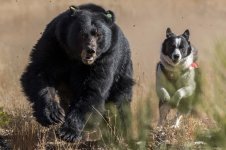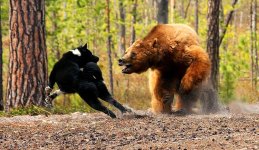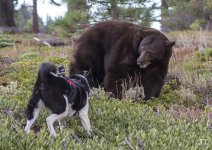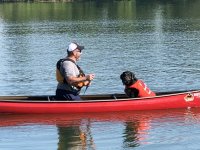Alan's dog Sadie looks like she is an amazing canoe dog also.
-
Happy Publication of Dickens' "A Christmas Carol" (1843)! 😠👻🩼🎄
You are using an out of date browser. It may not display this or other websites correctly.
You should upgrade or use an alternative browser.
You should upgrade or use an alternative browser.
What is the ideal canoe dog for a solo canoeist?
- Thread starter Glenn MacGrady
- Start date
ECS’s are 40lbs dogs in a 20 lbs package. Lots around these parts but I’ve yet to meet one that wasn’t bat crap crazy! My kids are all getting one when they get hunting age.I have a friend who is an excellent vet that specializes in hunting dogs and his all time favorite is field bred english cocker spaniels. Field bred and English being the key
Found this one the other day, excuse the kicker.
Attachments
They use them throughout the Rockies for managing grizzly bears through aversive conditioning. They're pretty effective.Maybe a Karelian Bear Dog, bred to hunt brown bear in Finland, an exellent canoe tripping country per another thread.
- Joined
- Jan 7, 2016
- Messages
- 960
- Reaction score
- 1,879
Karelian Bear dogs are great, if you don’t mind that they are interested in doing only what they want, whenever they want to (don’t mind at all). Every one I have been around had to be in a pen or on a leash. I know three guys that had them for use as Bear Biologists at Alaska Dept. of Fish & Game. Great for chasing bears, but that was all they are good for. Like all the Spitz Breeds they bark a lot.
I have a trapper friend that had a Finnish Spitz that was a wonderful companion for him. Learned only to yap, yap, yap at grouse but until it did, no one in our little town liked that dog and it’s constant barking at squirrels. My friend would sometimes be a day or so late to some functions, because the Finnish Spitz would not come when called. A ideal smaller sized and beautiful dog with a nice coat.
I tripped a couple of times with my dog team. They trotted along the shore as I paddled. They had a great time, but to portage the large amount dog food needed was a pain, I was glad we were only going to a trout lake two portages in. On one of the portages they chased a sow black bear and her cubs up into trees. All fun and games for them. The constant marking of territory was also a problem with the “boy’s” not so much with trees and bushes, not pleasant with packs and tents.
A smart female Border Collie is and has been my choice of dog companion for a long time. Don’t get one if you are not real active as they need something to do. They need a job! Over the years mine spent a lot of time herding my horses, sled dogs and children. Later dogs spend their free time herding red squirrels. If you don’t have a job for them they will find one. The worst one is herding cars, which will get them killed. I love mine as does PP but they aren’t for everyone. If you are somewhat old and sedentary don’t get a Border Collie.
I have a trapper friend that had a Finnish Spitz that was a wonderful companion for him. Learned only to yap, yap, yap at grouse but until it did, no one in our little town liked that dog and it’s constant barking at squirrels. My friend would sometimes be a day or so late to some functions, because the Finnish Spitz would not come when called. A ideal smaller sized and beautiful dog with a nice coat.
I tripped a couple of times with my dog team. They trotted along the shore as I paddled. They had a great time, but to portage the large amount dog food needed was a pain, I was glad we were only going to a trout lake two portages in. On one of the portages they chased a sow black bear and her cubs up into trees. All fun and games for them. The constant marking of territory was also a problem with the “boy’s” not so much with trees and bushes, not pleasant with packs and tents.
A smart female Border Collie is and has been my choice of dog companion for a long time. Don’t get one if you are not real active as they need something to do. They need a job! Over the years mine spent a lot of time herding my horses, sled dogs and children. Later dogs spend their free time herding red squirrels. If you don’t have a job for them they will find one. The worst one is herding cars, which will get them killed. I love mine as does PP but they aren’t for everyone. If you are somewhat old and sedentary don’t get a Border Collie.
My understanding is that the Karelian Bear Dog are best in pairs and they require a strong willed owner to manage them. Nice dogs.
- Joined
- Jul 6, 2021
- Messages
- 643
- Reaction score
- 1,174
I like the looks of Jake, please tell him I asked “Who’s a good boy?” and give him a treat.
I have two books from my youth still intact, Chandler Robbins’ 1966 Golden Book Guide to Field Identification to the Birds of North America. Even today, with Audubon and Sibley guides, it remains my go-to muscle memory page flipping bird book, despite being held together by a duct taped spine.
And a 1966 Observer’s Book of Dogs (S. M. Lampson, Ware & Co, London).
Ware & Co. published small pocket field guides on 40 different subjects, from Grasses to Cacti to Bird’s Eggs. Lichen, Fungi, Mosses, Ferns, Larger Moths, Pond Life. . . . . Nudes of Modern Art (very rare on the used market)
About the Vizsla, Lampson’s Observer’s Guide has this to say, dated from 55 years ago:
AKA “Hungarian Pointer, Yellow Pointer”
“Of the five national breeds of Hungary the Vizsla is the sole sporting dog, a breed which combines the duties of a Pointer, Setter and Retriever”
Blah, blah, blah. . . . “The Vizsla is expected to work fast, first finding game by scent, then pointing and, after it is shot, retrieving it”.
Height 25”
Weight 70-75lbs
Color dark sandy yellow
The coat is short and dense and without undercoat.
It is funny, and often sad, to look through that 50 year old guide and see the breeds that were ruined by physical attribute show-dog breeders. Our Chow, AKA “the Cantonese Butcher-dog, Oriental Spitz” or, seriously, the “Edible Dog” from the late ’50-early 60’s had an actual snout, as shown in the photo Observer’s photo, not the pushed in bulldog-face that later became popularized.
The book doesn’t mention Vizslas being unstinky when wet, but for a canoe tripping dog that is a huge plus. Some thread wander, but for sharing a tent, which are the least stinky-when-wet dog breeds?
Or which are wet dog odoriferous? And I’ll put water loving black Labs towards the stinky end of the scale. Or, maybe, which are unlikely to spend their free time swimming neck deep?
Casting the bones and opening that Observer’s Book of Dogs at random I can see Glenn with a Dandie Dinmont Terrier (Charlie’s Hope Terrier, Mustard and Pepper Terrier, Hold the Mayo Terrier)
https://www.akc.org/dog-breeds/dandie-dinmont-terrier/
Read the “History” bit of that entry. As a breed popularized in 1700 by Royals and other note worthies I bet they were also known as “Dumb as a Stump Terriers” by the 1800’s.
Breeding for physical attributes and ignoring working skills, temperament and personality ruined too many lines.
Mini-rant over.
I have two books from my youth still intact, Chandler Robbins’ 1966 Golden Book Guide to Field Identification to the Birds of North America. Even today, with Audubon and Sibley guides, it remains my go-to muscle memory page flipping bird book, despite being held together by a duct taped spine.
And a 1966 Observer’s Book of Dogs (S. M. Lampson, Ware & Co, London).
Ware & Co. published small pocket field guides on 40 different subjects, from Grasses to Cacti to Bird’s Eggs. Lichen, Fungi, Mosses, Ferns, Larger Moths, Pond Life. . . . . Nudes of Modern Art (very rare on the used market)
About the Vizsla, Lampson’s Observer’s Guide has this to say, dated from 55 years ago:
AKA “Hungarian Pointer, Yellow Pointer”
“Of the five national breeds of Hungary the Vizsla is the sole sporting dog, a breed which combines the duties of a Pointer, Setter and Retriever”
Blah, blah, blah. . . . “The Vizsla is expected to work fast, first finding game by scent, then pointing and, after it is shot, retrieving it”.
Height 25”
Weight 70-75lbs
Color dark sandy yellow
The coat is short and dense and without undercoat.
It is funny, and often sad, to look through that 50 year old guide and see the breeds that were ruined by physical attribute show-dog breeders. Our Chow, AKA “the Cantonese Butcher-dog, Oriental Spitz” or, seriously, the “Edible Dog” from the late ’50-early 60’s had an actual snout, as shown in the photo Observer’s photo, not the pushed in bulldog-face that later became popularized.
The book doesn’t mention Vizslas being unstinky when wet, but for a canoe tripping dog that is a huge plus. Some thread wander, but for sharing a tent, which are the least stinky-when-wet dog breeds?
Or which are wet dog odoriferous? And I’ll put water loving black Labs towards the stinky end of the scale. Or, maybe, which are unlikely to spend their free time swimming neck deep?
Casting the bones and opening that Observer’s Book of Dogs at random I can see Glenn with a Dandie Dinmont Terrier (Charlie’s Hope Terrier, Mustard and Pepper Terrier, Hold the Mayo Terrier)
https://www.akc.org/dog-breeds/dandie-dinmont-terrier/
Read the “History” bit of that entry. As a breed popularized in 1700 by Royals and other note worthies I bet they were also known as “Dumb as a Stump Terriers” by the 1800’s.
Breeding for physical attributes and ignoring working skills, temperament and personality ruined too many lines.
Mini-rant over.
I was dogsitting for my daughters dog. It was part herding dog. We walk our dogs loose around here but I do carry a leash in case people/cars come by. The dog had been obedient; until it wasn't and found something more tempting than listening to me.
It chased a passing car before I could attach a leash. It ran up the blind side ( dog was faster than 20 mph ) and attempted to herd the bumper. Did not end well for the dog
We had a pen for our own border collie 25 years ago. We put it out in the pen for a late night visit. Unbeknownst to us there was already a deer in there... Things were interesting.. All was well at the end.
I still like my Carolina Dog mix. Even damp he does not stink. He has never need a bath ever. CDs have no odor. He is a prolific gardener and supreme digger after rodents. He has the faint sweet smell of dirt when he comes in. But it dissipates as CDs groom themselves like a cat.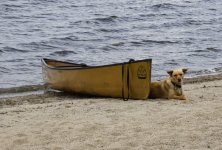
It chased a passing car before I could attach a leash. It ran up the blind side ( dog was faster than 20 mph ) and attempted to herd the bumper. Did not end well for the dog
We had a pen for our own border collie 25 years ago. We put it out in the pen for a late night visit. Unbeknownst to us there was already a deer in there... Things were interesting.. All was well at the end.
I still like my Carolina Dog mix. Even damp he does not stink. He has never need a bath ever. CDs have no odor. He is a prolific gardener and supreme digger after rodents. He has the faint sweet smell of dirt when he comes in. But it dissipates as CDs groom themselves like a cat.

Our local bear specialist with the Nevada Dept of Wildlife has two Kerilian bear dogs. He deals with bear/people problems at Lake Tahoe all the time. Some of the bears have quit hibernating. I met him and his two dogs recently. A great guy and his dogs were easy to get along with. They look like Border Collies that have taken steroids' and lifted weights.
I have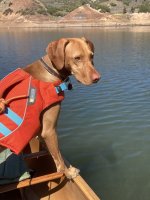
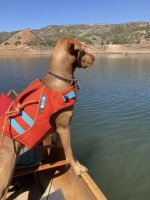 a female Vizsla that weighs in at 38 pounds- which is at the low end of the size range for the breed. As others have noted, she also does not smell and grooms herself like a cat. Unlike many v’s, cold doesn’t bother her, but mosquitoes do. She gets welts which show through her coat when bitten, and chases them in the tent. Sprinting in the snow is one of her favorite pastimes. Her preferred position in a canoe is standing in the bow, sometimes on the bow seat, with front paws on the deck. I have had limited success getting her to lie down for long- too many new sights and smells. Fortunately she doesn’t tip the canoe too much when she switches sides. So far I have only taken her solo in my tandem canoes. She is now 3 and I am hoping to try her in the Phoenix this year. Apparently Vizsla’s vary greatly in some ways. Ziva can swim if forced to, but doesn’t go in voluntarily. I kind of like that- no worry about her jumping out unless she is close enough to land on the shore. No experience with bears, but she lets us know if a moose or mountain lion is approaching. She may not be the perfect canoe dog- but not far off in my opinion.
a female Vizsla that weighs in at 38 pounds- which is at the low end of the size range for the breed. As others have noted, she also does not smell and grooms herself like a cat. Unlike many v’s, cold doesn’t bother her, but mosquitoes do. She gets welts which show through her coat when bitten, and chases them in the tent. Sprinting in the snow is one of her favorite pastimes. Her preferred position in a canoe is standing in the bow, sometimes on the bow seat, with front paws on the deck. I have had limited success getting her to lie down for long- too many new sights and smells. Fortunately she doesn’t tip the canoe too much when she switches sides. So far I have only taken her solo in my tandem canoes. She is now 3 and I am hoping to try her in the Phoenix this year. Apparently Vizsla’s vary greatly in some ways. Ziva can swim if forced to, but doesn’t go in voluntarily. I kind of like that- no worry about her jumping out unless she is close enough to land on the shore. No experience with bears, but she lets us know if a moose or mountain lion is approaching. She may not be the perfect canoe dog- but not far off in my opinion.

 a female Vizsla that weighs in at 38 pounds- which is at the low end of the size range for the breed. As others have noted, she also does not smell and grooms herself like a cat. Unlike many v’s, cold doesn’t bother her, but mosquitoes do. She gets welts which show through her coat when bitten, and chases them in the tent. Sprinting in the snow is one of her favorite pastimes. Her preferred position in a canoe is standing in the bow, sometimes on the bow seat, with front paws on the deck. I have had limited success getting her to lie down for long- too many new sights and smells. Fortunately she doesn’t tip the canoe too much when she switches sides. So far I have only taken her solo in my tandem canoes. She is now 3 and I am hoping to try her in the Phoenix this year. Apparently Vizsla’s vary greatly in some ways. Ziva can swim if forced to, but doesn’t go in voluntarily. I kind of like that- no worry about her jumping out unless she is close enough to land on the shore. No experience with bears, but she lets us know if a moose or mountain lion is approaching. She may not be the perfect canoe dog- but not far off in my opinion.
a female Vizsla that weighs in at 38 pounds- which is at the low end of the size range for the breed. As others have noted, she also does not smell and grooms herself like a cat. Unlike many v’s, cold doesn’t bother her, but mosquitoes do. She gets welts which show through her coat when bitten, and chases them in the tent. Sprinting in the snow is one of her favorite pastimes. Her preferred position in a canoe is standing in the bow, sometimes on the bow seat, with front paws on the deck. I have had limited success getting her to lie down for long- too many new sights and smells. Fortunately she doesn’t tip the canoe too much when she switches sides. So far I have only taken her solo in my tandem canoes. She is now 3 and I am hoping to try her in the Phoenix this year. Apparently Vizsla’s vary greatly in some ways. Ziva can swim if forced to, but doesn’t go in voluntarily. I kind of like that- no worry about her jumping out unless she is close enough to land on the shore. No experience with bears, but she lets us know if a moose or mountain lion is approaching. She may not be the perfect canoe dog- but not far off in my opinion.That is a beautiful Vizsla! Mine loves a good romp in the snow covered timber as well. I loved your pics. I know what you mean about the welts under the skin ... good thing those dogs are tough. Thanks for posting. Hope to see more pics of you two in a trip report.
Bob.
Bob.
Looks like a great dog, but I do not want them standing on the gunwales. I train mine to sit in the bottom of the canoe. They lie down for rapids.
As I stated in my first post, I dry land train all my dogs at home way before we hit the water. IMHO the only safe large dog in a canoe is the one lying still in the bottom of the boat. Dog does not leave his position in the canoe once grounded until told to do so. Found this out early in life one spring when portage take out was part of the rapid because of high water, and on another occasion when a porcupine was rambling through a campsite I pulled in to investigate.


I have a friend who is an excellent vet that specializes in hunting dogs and his all time favorite is field bred english cocker spaniels. Field bred and English being the key
Rubbaboo Said:
ECS’s are 40lbs dogs in a 20 lbs package. Lots around these parts but I’ve yet to meet one that wasn’t bat crap crazy! My kids are all getting one when they get hunting age.
I'm curious in what way you've found them to be crazy. Hyperactive or mentally off?
I have little to no personal experience them other than the high praises my friend sings of them. It was when I started reading about the breed characteristics that I was struck by how similar my Sadie was to what I'd read and, like I mentioned earlier in the thread, I found pictures of some that look quite similar to her, making me wonder if there isn't some European cocker mixed in there.
From what I've read and what my friend has experienced I always thought one of their strong suits was that they did not tend to be 'bat crap crazy'. That they tended to be more low key than most other field dogs. Of course all dogs are individuals.
My whole life I've had hunting dogs (3 springers, a Brittaney, and now Sadie, whatever she is) but I don't hunt. All these dogs have had natural hunting instincts, some better than others, which they've displayed when out walking/canoeing. I've never found it to be a problem. Rather it's enjoyable to see them interacting with their environment and they find a lot of wildlife I normally would have missed (Sadie is excellent at finding grouse tucked in the bushes along portage trails). They are not allowed, nor do they have a strong desire, to run off chasing game. Mostly they find and point. They'd chase a rabbit that flushed under foot and would chase surprised deer but they didn't seem to harbor any illusions of actually running them down so would quickly abandon the chase once outpaced.
Perhaps it's because I don't hunt that these field dogs don't act crazy, because those instincts have never been finely honed. Nor has there been a reward system for finding game. Instead of turning into the end-all be-all of their existence it's just something they nonchalantly do.
The Brittany I had when I was a very young kid tended to be a holy terror of energy. She died young so I don't know if she would have mellowed or not. The Springer she was paired with was a handful when young but settled down well after a few years (especially after his partner in crime died) and lived a long life following me around on by bicycle as we went fishing and spent a lot of time in our canoe and small fishing boat.
The Springers I had after that in my adulthood were overall calm dogs and excellent companions. One of them is the reason I got into canoeing. I'd gotten to love being on the water in a kayak and felt bad leaving him at home so I bought my first solo canoe (Bell Magic) and the two of us spent many hours catching bass from that boat (he loved fishing). The kayaks died away and the solo canoe fleet proliferated.
Alan
Hey Alan
Hyperactive, but in a good way for trialing and hunting. As the saying goes, you can take it out of them, but you can’t put it into them. A laid back spaniel, be it ES or EC just isn’t desirable in the field, however most seem to switch off in the house fairly well. All of mine have taken a few years to “find” that switch and learn manners but it’s a tough row to hoe and for an inexperienced handler/owner it could be overwhelming. I live in an area with a high proportion of upland dogs and it’s pretty common to see adds for rescue Spaniels that owners just can’t handle, they’re right up there with Borders in that regard. For field bred spaniels “ bat crap crazy” is a must cause it’s what makes them hungry for birds, but you better be prepared.
Right now I run ES‘s because of their longer legs, the late season snow in these parts runs a EC down too fast, but I have lots of hunting buddies who hunt and trial the littler dogs as well as ES‘s and without a doubt, the EC’s are harder to train and need more pressure then the ES, which Is no doubt because of their more energetic temperament.
Certainly there is going to be variation within the breed, every breeder puts their personal touches on their line and regionally dogs will differ to meet their environmental requirements. That’s the beauty of being field bred and not conforming to a standard. A dog bred on a southern plantation to flush and retrieve pointed quail (sitting steady on a horse drawn wagon while waiting for the pointers to do their job) is going to be bred slightly different than a high plains cattail kicking pheasant specialist.
Im all for EC’s, and certainly with proper training they‘d make a great solo buddy, however I’d definitely want to meet and spend time with the parents/breeder first. If your vet friend is still breeding, you‘re fortunate to have a connection to a line that meets your needs!
Hyperactive, but in a good way for trialing and hunting. As the saying goes, you can take it out of them, but you can’t put it into them. A laid back spaniel, be it ES or EC just isn’t desirable in the field, however most seem to switch off in the house fairly well. All of mine have taken a few years to “find” that switch and learn manners but it’s a tough row to hoe and for an inexperienced handler/owner it could be overwhelming. I live in an area with a high proportion of upland dogs and it’s pretty common to see adds for rescue Spaniels that owners just can’t handle, they’re right up there with Borders in that regard. For field bred spaniels “ bat crap crazy” is a must cause it’s what makes them hungry for birds, but you better be prepared.
Right now I run ES‘s because of their longer legs, the late season snow in these parts runs a EC down too fast, but I have lots of hunting buddies who hunt and trial the littler dogs as well as ES‘s and without a doubt, the EC’s are harder to train and need more pressure then the ES, which Is no doubt because of their more energetic temperament.
Certainly there is going to be variation within the breed, every breeder puts their personal touches on their line and regionally dogs will differ to meet their environmental requirements. That’s the beauty of being field bred and not conforming to a standard. A dog bred on a southern plantation to flush and retrieve pointed quail (sitting steady on a horse drawn wagon while waiting for the pointers to do their job) is going to be bred slightly different than a high plains cattail kicking pheasant specialist.
Im all for EC’s, and certainly with proper training they‘d make a great solo buddy, however I’d definitely want to meet and spend time with the parents/breeder first. If your vet friend is still breeding, you‘re fortunate to have a connection to a line that meets your needs!
I'm curious in what way you've found them to be crazy. Hyperactive or mentally off?
I have little to no personal experience them other than the high praises my friend sings of them. It was when I started reading about the breed characteristics that I was struck by how similar my Sadie was to what I'd read and, like I mentioned earlier in the thread, I found pictures of some that look quite similar to her, making me wonder if there isn't some European cocker mixed in there.
From what I've read and what my friend has experienced I always thought one of their strong suits was that they did not tend to be 'bat crap crazy'. That they tended to be more low key than most other field dogs. Of course all dogs are individuals.
My whole life I've had hunting dogs (3 springers, a Brittaney, and now Sadie, whatever she is) but I don't hunt. All these dogs have had natural hunting instincts, some better than others, which they've displayed when out walking/canoeing. I've never found it to be a problem. Rather it's enjoyable to see them interacting with their environment and they find a lot of wildlife I normally would have missed (Sadie is excellent at finding grouse tucked in the bushes along portage trails). They are not allowed, nor do they have a strong desire, to run off chasing game. Mostly they find and point. They'd chase a rabbit that flushed under foot and would chase surprised deer but they didn't seem to harbor any illusions of actually running them down so would quickly abandon the chase once outpaced.
Perhaps it's because I don't hunt that these field dogs don't act crazy, because those instincts have never been finely honed. Nor has there been a reward system for finding game. Instead of turning into the end-all be-all of their existence it's just something they nonchalantly do.
The Brittany I had when I was a very young kid tended to be a holy terror of energy. She died young so I don't know if she would have mellowed or not. The Springer she was paired with was a handful when young but settled down well after a few years (especially after his partner in crime died) and lived a long life following me around on by bicycle as we went fishing and spent a lot of time in our canoe and small fishing boat.
The Springers I had after that in my adulthood were overall calm dogs and excellent companions. One of them is the reason I got into canoeing. I'd gotten to love being on the water in a kayak and felt bad leaving him at home so I bought my first solo canoe (Bell Magic) and the two of us spent many hours catching bass from that boat (he loved fishing). The kayaks died away and the solo canoe fleet proliferated.
Ala
Last edited:
A good friend of mine had one. Easily the smartest dog I've ever met. He not only understood words, he would follow conversations.My daughter and son-in-law have a "portie" - a portuguese water dog. When he was 6 months old, we took him on a 5-day canoe trip on Little Tupper Lake in the Adirondacks. He was a highlight of the trip - he did great in their tandem canoe and took advantage of every opportunity to go for a swim with us. He was great in the campsite too - always willing to fetch a stick and then play keep-away with it. We had an island campsite for a few nights, which was ideal since he could roam freely and we didn't have to worry about him taking off into the woods.
A little over 4 years ago, my wife and I decided it was time for a new pup…..I believe I posted about it back then so I won’t run thru the whole story again….I was hoping to find something under 50# full grown….my wife fell in love with a rescue puppy that our niece 7 hours away was fostering for a local rescue. She assured us that the vet said he would be lucky to reach 45 #…..2 years later, he was over 100#’s! Barely fit in my Northstar Phoenix….he couldn’t get comfortable because he couldn’t turn around….The bright side? Convinced the wife I needed another canoe….
Attachments
Hyperactive, but in a good way for trialing and hunting. As the saying goes, you can take it out of them, but you can’t put it into them. A laid back spaniel, be it ES or EC just isn’t desirable in the field, however most seem to switch off in the house fairly well. All of mine have taken a few years to “find” that switch and learn manners but it’s a tough row to hoe and for an inexperienced handler/owner it could be overwhelming. I live in an area with a high proportion of upland dogs and it’s pretty common to see adds for rescue Spaniels that owners just can’t handle, they’re right up there with Borders in that regard. For field bred spaniels “ bat crap crazy” is a must cause it’s what makes them hungry for birds, but you better be prepared.
Right now I run ES‘s because of their longer legs, the late season snow in these parts runs a EC down too fast, but I have lots of hunting buddies who hunt and trial the littler dogs as well as ES‘s and without a doubt, the EC’s are harder to train and need more pressure then the ES, which Is no doubt because of their more energetic temperament.
Certainly there is going to be variation within the breed, every breeder puts their personal touches on their line and regionally dogs will differ to meet their environmental requirements. That’s the beauty of being field bred and not conforming to a standard. A dog bred on a southern plantation to flush and retrieve pointed quail (sitting steady on a horse drawn wagon while waiting for the pointers to do their job) is going to be bred slightly different than a high plains cattail kicking pheasant specialist.
Im all for EC’s, and certainly with proper training they‘d make a great solo buddy, however I’d definitely want to meet and spend time with the parents/breeder first. If your vet friend is still breeding, you‘re fortunate to have a connection to a line that meets your needs!
Thanks for the response. All my springers came from small local breeders and Sadie, while she has a lot of bird dog in her, is not likely to be from a long line of field bred royalty (or why would she have been in a two bit rescue?). So when I think about it I've probably never been around a true field bred dog, which is why I'm used to them being a little calmer.
I just did some searching on online forums and they definitely backed up what you said. That the field bred English Cockers have a LOT of energy. So my earlier advice to seek out a field bred dog was wrong. Would probably be better suited to find a breeder that was churning out nice family dogs, which would likely retain some hunting instincts, rather than finding a lean, mean, bird flushing machine.
Alan
Bob, you have written and pictured passionately about Jake in this thread, but I see from your recent thread in the Winter Camping and Trekking forum that you have two Vizslas, Jake and Gunner. Does Gunner stay at home when Jake goes canoeing?Vizsla
Hey Glenn,
Yes, on trips Gunner is not included, he stays home with my wife. Jake and I are nationally certified as a therapy team. I worked with high school adjudicated youth and Jake came to work with me. Jake has much more training … and focus than Gunner. When things get a little uncertain, or scary Gunner panics. Jake, looks to me for what to do in those times. When the wolves were trying to scare Jake out of the tent, or when the tornadoes were ripping up the timber right in front of us, or when people in the airport mobbed the cute little red dog, he looked at me to know what to do and with voice or hand commands we got through it. Gunner is a great dog but I am not confident he can handle those few times when things go south and I need him to listen immediately.
Both dogs are truly family. We explore the Wisconsin River back country, and the hilly timber together. Both are well behaved in the canoe or tent and trails. But on long trips to the back country, Gunner stays home with Moma.
I think a big mistake made with our pups was Jake was my dog, Gunner was my wife’s. I worked more with Jake , should have been more involved with both. Gunner is an awesome dog but does not have half the confidence Jake does. I which I could have a do over for his 1st two years.
Yes, on trips Gunner is not included, he stays home with my wife. Jake and I are nationally certified as a therapy team. I worked with high school adjudicated youth and Jake came to work with me. Jake has much more training … and focus than Gunner. When things get a little uncertain, or scary Gunner panics. Jake, looks to me for what to do in those times. When the wolves were trying to scare Jake out of the tent, or when the tornadoes were ripping up the timber right in front of us, or when people in the airport mobbed the cute little red dog, he looked at me to know what to do and with voice or hand commands we got through it. Gunner is a great dog but I am not confident he can handle those few times when things go south and I need him to listen immediately.
Both dogs are truly family. We explore the Wisconsin River back country, and the hilly timber together. Both are well behaved in the canoe or tent and trails. But on long trips to the back country, Gunner stays home with Moma.
I think a big mistake made with our pups was Jake was my dog, Gunner was my wife’s. I worked more with Jake , should have been more involved with both. Gunner is an awesome dog but does not have half the confidence Jake does. I which I could have a do over for his 1st two years.
Similar threads
- Replies
- 16
- Views
- 3K

